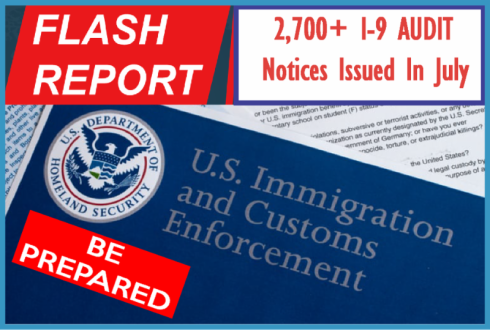
How Is Your Written Immigration Compliance Policy Looking?
What Just Happened?
During the week of July 16, 2018, Immigration and Customs Enforcement’s (ICE) Homeland Security Investigations (HSI) delivered Notice of Inspection (NOI)/audit notices throughout the U.S. And, HSI served 2,738 NOIs and made 32 arrests in one-week.
ICE’s Delivery of Notices of Inspection
ICE also announced that since January, 2018, I-9 audit notices were served to more than 5,200 businesses around the U.S. During Phase-1 of the operation – Jan. 29 to March 30, 2018 – HSI served 2,540 NOIs and made 61 arrests. At the present rate, ICE-HSI will reach more than 8,500 NOIs this year! This is over 5,000 audits more than the highest previous amount.
HSI is enforcing its commitment to increase the number of I-9 audits to create a culture of compliance among employers, says the HSI Director. Its worksite enforcement strategy focuses on the criminal prosecution of employers who knowingly break the law, by using I-9 audits and civil fines to encourage compliance of the law.
Statistical Evidence
Failure to follow the Immigration Reform & Control Act can result in criminal and civil penalties. In FY17, businesses were ordered to pay $7.8 million in civil fines and $97.6 million in judicial forfeitures, fines and restitution with Asplundh Tree Experts assessed $95 million. This is the largest payment ever levied in an immigration case.
In FY 2018 to date, HSI opened 6,093a worksite investigations (I-9 audits) and made 675 criminal and 984 administrative worksite-related arrests, respectively. In FY 2017, HSI opened 1,716 worksite investigations; initiated 1,360 I-9 audits; and made 139 criminal arrests and 172 administrative arrests related to worksite enforcement.
Preparing for ICE I-9 Audit
Will your company be targeted next? The best way to prepare for an I-9 inspection is having an experienced outsider conduct an I-9 audit. Doing so highlights numerous errors found, and corrects them so that if ICE inspects your I-9 forms, the errors are viewed as minor … unfortunately since almost every company has I-9 errors, they risk getting penalized.
Also – many if not all of your employees are U.S. citizens – which causes substantive and technical I-9 errors. Employers assume that by using E-Verify they are okay. While E-Verify is excellent in establishing who is authorized to work, you should know that it cannot locate substantive or technical errors on the I-9 forms.
If an ICE I-9 audit occurs, getting a lawyer involved as soon possible is suggested. An attorney can help the company negotiate a few days’ extension in responding to the subpoena. They can often get the list of requested documents reduced, as well as helping you prepare to respond in a methodical and logical way.
Being prepared for a NOI/subpoena requires a company to have proper procedures in place ‘upon hiring’. The best way to have these procedures in place is to prepare a written Immigration Compliance Policy. This policy ensures that the employees responsible for completing I-9 records on behalf of the company are properly trained to do so. For the novice, it’s hard to tell the difference between a green card and a work authorization document issued to a recipient of DACA or TPS, since one represents permanent work authorization that should never be re-verified, and the other requires the employer to re-verify the I-9 form upon the document’s expiration.
Tips To Remain I-9 Compliant:
- Be prepared to handle an ICE worksite enforcement action and understand its dynamics;
- Conduct regular internal I-9 audits and training and be able to spot issues and fraudulent documents. Contact our office for assistance in addressing I-9 issues, audits, and developing training programs;
- Review company immigration corporate compliance programs using Sarbanes-Oxley considerations at the worksite, corporate due diligence in mergers and acquisitions, subcontractor liability, and E-Verify.
CalWorkSafety offers detailed guidance on how I-9s are prepared and completed.
We assist with reviewing I-9 records and training employees on how to handle the I-9 process properly. For more information send an email to: dondressler1@hotmail.com or call us at: 949-533-3742.
The Bottom Line:
Our Virtual HR Department offers effective hands-on Management and Staff training dealing with Mandated Regulations. By simplifying the employee relations and compliance elements we help clients reduce workers’ compensation premiums, prevent discrimination and harassment claims, and settle/avoid employee claims. To learn more about preparing for 2019 HR compliance, call us at 949-533-3742 or email:
dondressler1@hotmail.com
Visit our website: www.calworksafety.com or Call: 949-533-3742



